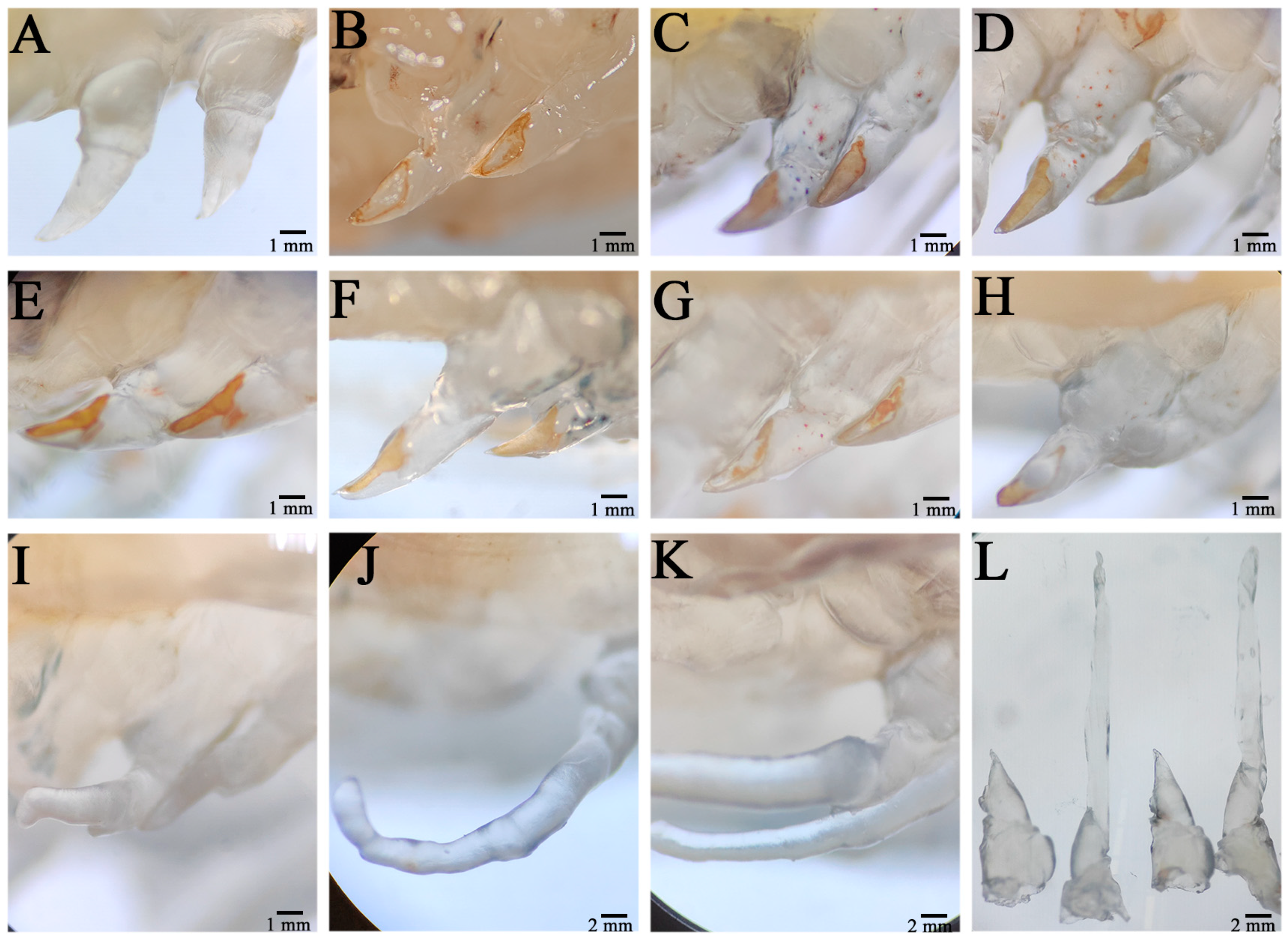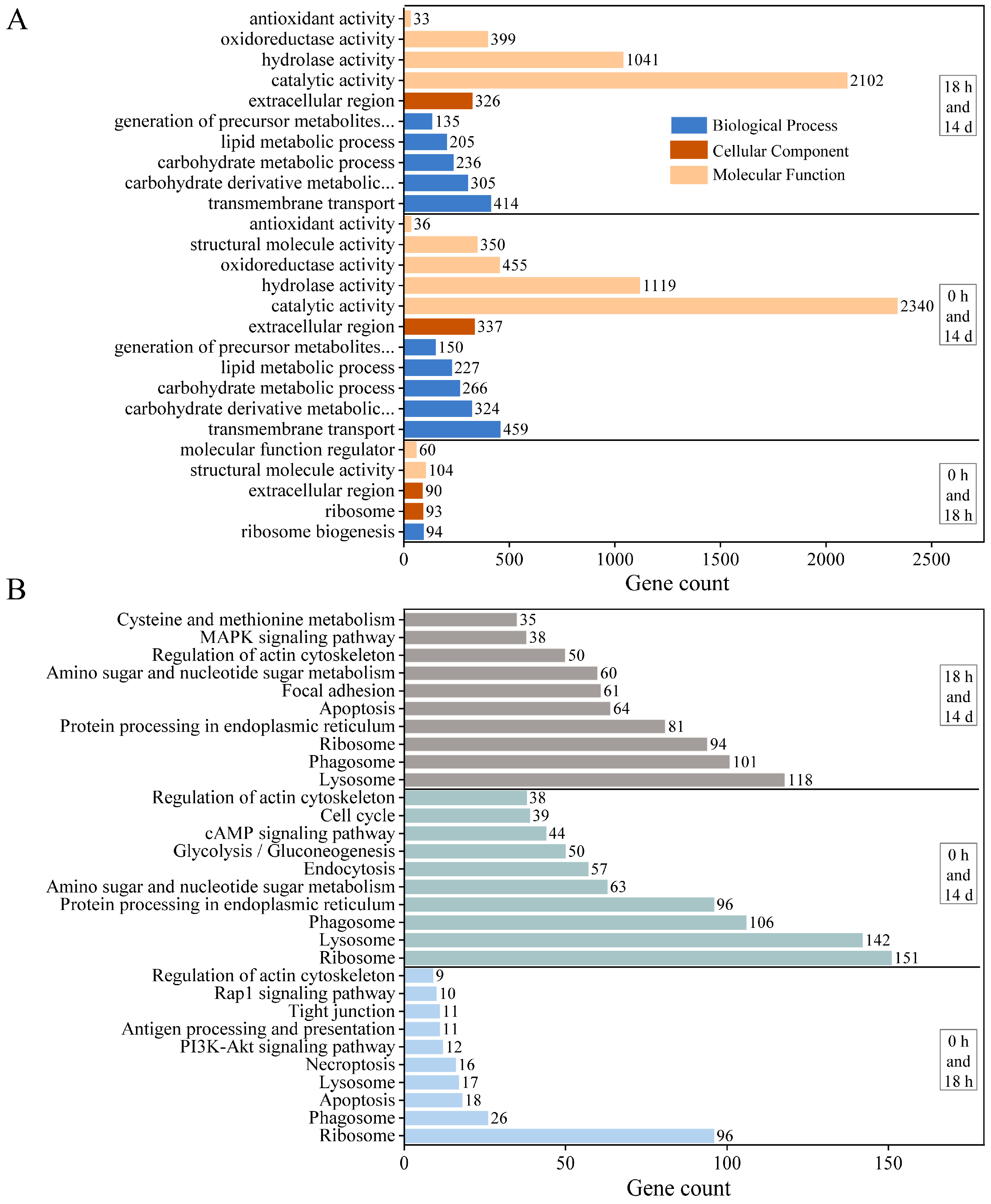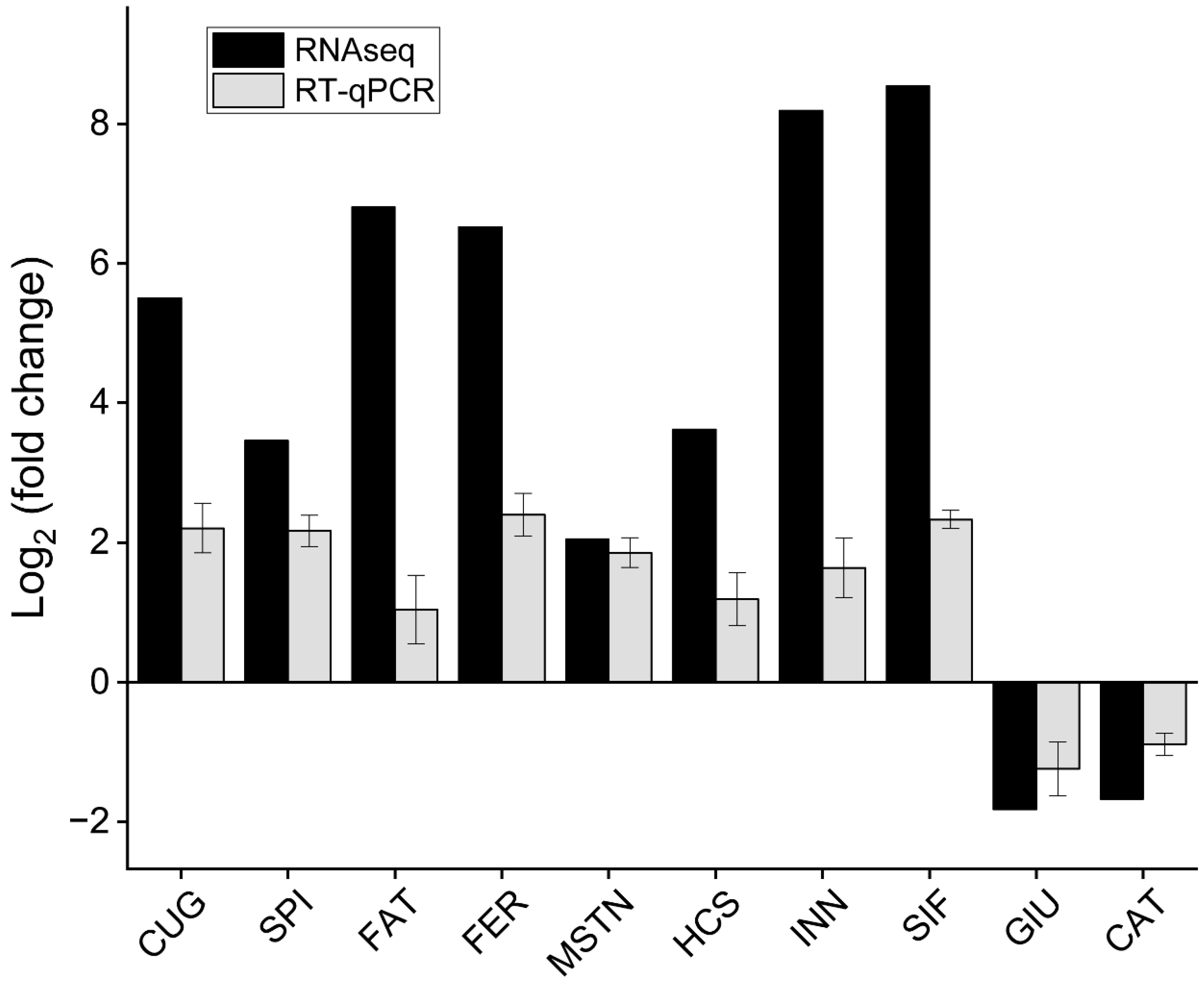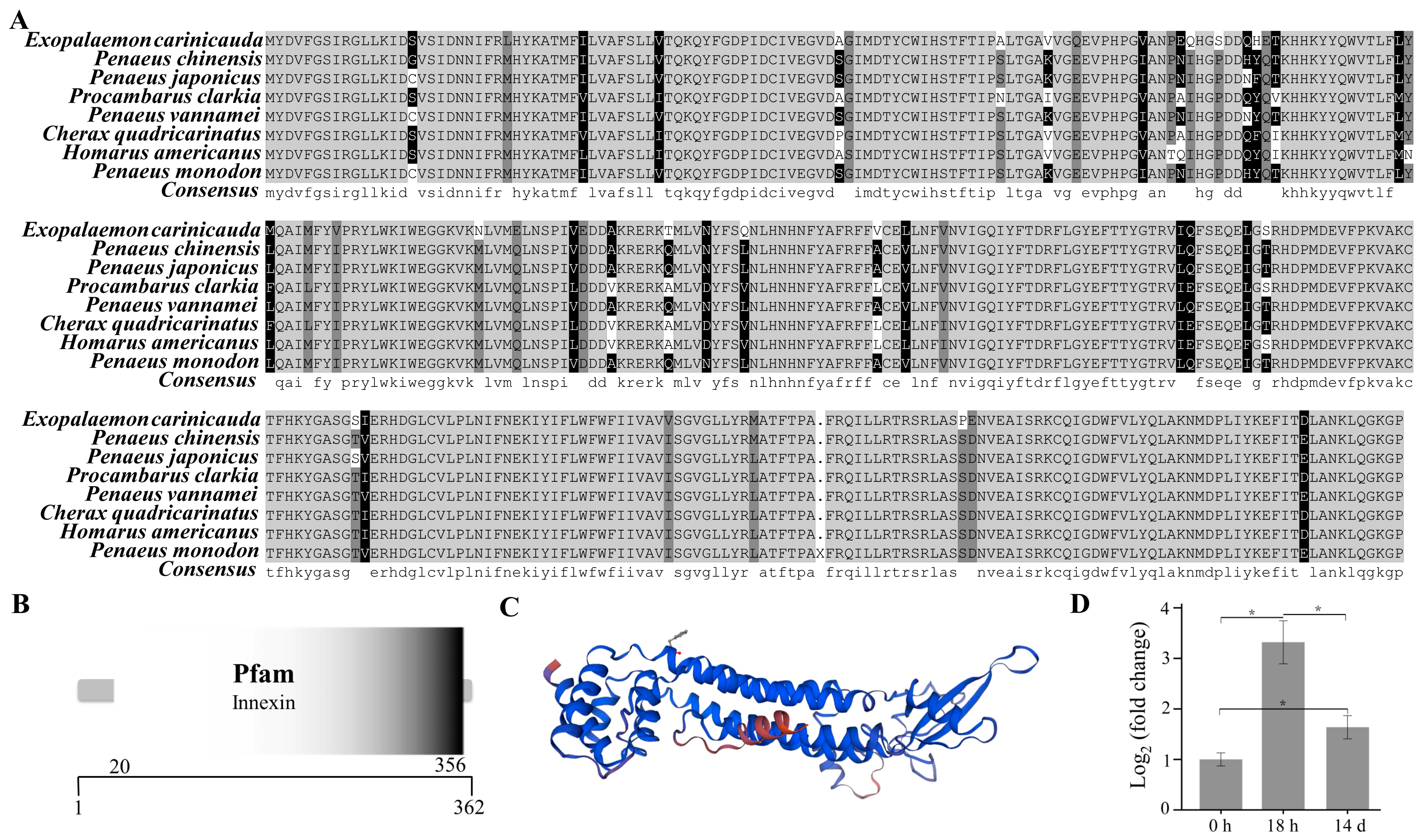Morphological and Molecular Changes during Limb Regeneration of the Exopalaemon carinicauda
Abstract
:Simple Summary
Abstract
1. Introduction
2. Method
2.1. Samples
2.2. Treatment and Sampling
2.3. Histological Analysis
2.4. RNA Extraction and cDNA Synthesis
2.5. Transcriptome Sequencing and Assembly
2.6. Experimental Verification Using RT–qPCR
2.7. Homologous Cloning and Sequence Analysis
3. Results
3.1. Morphological Observation of Limb Regeneration in E. carinicauda
3.2. Histological Analysis of Early-Stage Regeneration of Appendages
3.3. Transcriptome Sequencing and Assembly
3.4. Functional Annotation Analysis
3.5. Identification of DEGs
3.6. Functional Annotation and Pathway Assignment of DEGs
3.7. Quantitative PCR to Verify DEGs
3.8. Structure and Phylogenetic Analysis
4. Discussion
5. Conclusions
Supplementary Materials
Author Contributions
Funding
Institutional Review Board Statement
Informed Consent Statement
Data Availability Statement
Conflicts of Interest
References
- Mattoni, C.I.; García-Hernández, S.; Botero-Trujillo, R.; Ochoa, J.A.; Ojanguren-Affilastro, A.A.; Pinto-da-Rocha, R.; Prendini, L. Scorpion Sheds ‘Tail’ to Escape: Consequences and Implications of Autotomy in Scorpions (Buthidae: Ananteris). PLoS ONE 2015, 10, e0116639. [Google Scholar] [CrossRef] [PubMed]
- Minelli, A.; Boxshall, G.; Fusco, G. Arthropod Biology and Evolution; Springer Nature: Padova, Italy, 2013; Volume 1, pp. 1–15. [Google Scholar]
- Barria, E.M.; Gonzalez, M.I. Effect of autotomy and regeneration of the chelipeds on growth and development in Petrolisthes laevigatus (Guérin, 1835) (Decapoda, Anomura, Porcellanidae). Crustaceana 2008, 81, 641–652. [Google Scholar] [CrossRef]
- Yue, W.; Chen, J.; Ci, Y.; Huang, S.; Wang, J.; Wang, C. Effects of limb regeneration on molt, growth and related gene expression in Chinese mitten crab (Eriocheir sinensis). J. Zhejiang Univ. (Agric. Life Sci.) 2016, 42, 502–508. [Google Scholar]
- Skinner, D.M. Interacting factors in the control of the crustacean molt cycle. Am. Zool. 1985, 25, 275–284. [Google Scholar] [CrossRef]
- Mykles, D.L. Interactions between limb regeneration and molting in decapod crustaceans. Am. Zool. 2001, 41, 399–406. [Google Scholar] [CrossRef]
- Hopkins, P.M.; Das, S. Regeneration in crustaceans. Nat. Hist. Crustac. 2015, 4, 168–198. [Google Scholar]
- Gong, J.; Yu, K.; Shu, L.; Ye, H.; Li, S.; Zeng, C. Evaluating the effects of temperature, salinity, starvation and autotomy on molting success, molting interval and expression of ecdysone receptor in early juvenile mud crabs, Scylla paramamosain. J. Exp. Mar. Biol. Ecol. 2015, 464, 11–17. [Google Scholar] [CrossRef]
- Rao, K.R.; Conklin, P.J.; Brannon, A. Inhibition of Limb Regeneration in the Grass Shrimp. Pentachlorophenol. Chem. Pharmacol. Environ. Toxicol. 2013, 12, 193. [Google Scholar]
- Rao, K.R.; Conklin, P.J.; Brannon, A.C. Inhibition of limb regeneration in the grass shrimp, Palaemonetes pugio, by sodium pentachlorophenate. Pentachlorophenol. Chem. Pharmacol. Environ. Toxicol. 1978, 12, 193–203. [Google Scholar]
- Hopkins, P. Ecdysteroids and regeneration in the fiddler crab Uca pugilator. J. Exp. Zool. 1989, 252, 293–299. [Google Scholar] [CrossRef]
- Hopkins, P.M. Limb regeneration in the fiddler crab, Uca pugilator: Hormonal and growth factor control. Am. Zool. 2001, 41, 389–398. [Google Scholar] [CrossRef]
- Yokoyama, H.; Ogino, H.; Stoick-Cooper, C.L.; Grainger, R.M.; Moon, R.T. Wnt/β-catenin signaling has an essential role in the initiation of limb regeneration. Dev. Biol. 2007, 306, 170–178. [Google Scholar] [CrossRef] [PubMed]
- Koriyama, Y.; Homma, K.; Sugitani, K.; Higuchi, Y.; Matsukawa, T.; Murayama, D.; Kato, S. Upregulation of IGF-I in the goldfish retinal ganglion cells during the early stage of optic nerve regeneration. Neurochem. Int. 2007, 50, 749–756. [Google Scholar] [CrossRef] [PubMed]
- Wang, J.; Chen, X.; Hou, X.; Wang, J.; Yue, W.; Huang, S.; Xu, G.; Yan, J.; Lu, G.; Hofreiter, M. “Omics” data unveil early molecular response underlying limb regeneration in the Chinese mitten crab, Eriocheir sinensis. Sci. Adv. 2022, 8, eabl4642. [Google Scholar] [CrossRef] [PubMed]
- Shibata, E.; Yokota, Y.; Horita, N.; Kudo, A.; Abe, G.; Kawakami, K.; Kawakami, A. Fgf signalling controls diverse aspects of fin regeneration. Development 2016, 143, 2920–2929. [Google Scholar] [CrossRef]
- Li, J.; Tian, Y.; Li, X.; Zuo, J.; Zhao, R.; Sun, J. Insulin-like signaling promotes limb regeneration in the Chinese mitten crab (Eriocheir sinensis). Fish Shellfish Immunol. 2022, 122, 268–275. [Google Scholar] [CrossRef] [PubMed]
- Fu, Y.; Zhu, F.; Liu, L.; Lu, S.; Ren, Z.; Mu, C.; Li, R.; Song, W.; Shi, C.; Ye, Y. iTRAQ-based proteomic analysis identifies proteins involved in limb regeneration of swimming crab Portunus trituberculatus. Comp. Biochem. Physiol. Part D Genom. Proteom. 2018, 26, 10–19. [Google Scholar] [CrossRef] [PubMed]
- Rani, B.; Sharma, V. Transcriptome profiling: Methods and applications—A review. Agric. Rev. 2017, 38, 271–281. [Google Scholar] [CrossRef]
- Stark, R.; Grzelak, M.; Hadfield, J. RNA sequencing: The teenage years. Nat. Rev. Genet. 2019, 20, 631–656. [Google Scholar] [CrossRef]
- Yue, W.; Yuan, R.; Jang, D.; Guo, X.; Li, F.; Qian, X. Transcriptome analysis of Litopenaeus vannamei during the early stage of limb regeneration process. Isr. J. Aquac. Bamidgeh 2023, 75, 1–10. [Google Scholar] [CrossRef]
- Shinji, J.; Gotoh, H.; Miyanishi, H.; Lavine, M.D.; Lavine, L.C. The activin signaling transcription factor Smox is an essential regulator of appendage size during regeneration after autotomy in the crayfish. Evol. Dev. 2019, 21, 44–55. [Google Scholar] [CrossRef] [PubMed]
- Gao, H.; Ma, H.; Sun, J.; Xu, W.; Gao, W.; Lai, X.; Yan, B. Expression and function analysis of crustacyanin gene family involved in resistance to heavy metal stress and body color formation in Exopalaemon carinicauda. J. Exp. Zool. Part B Mol. Dev. Evol. 2021, 336, 352–363. [Google Scholar] [CrossRef]
- Hu, G.; Wang, W.; Xu, K.; Wang, C.; Liu, D.; Xu, J.; Yan, B.; Ji, N.; Gao, H. Transcriptomic and Metabolomic Analyses of Palaemon carinicauda Hepatopancreas in Response to Enterocytozoon hepatopenaei (EHP) Infection. Fishes 2023, 8, 92. [Google Scholar] [CrossRef]
- Xing, C.; Xiong, J.; Xie, S.; Guo, H.; Hua, S.; Yao, Y.; Zhu, J.; Yan, B.; Shen, X.; Gao, H. Comparative transcriptome and gut microbiota analysis of Exopalaemon carinicauda with different growth rates from a full-sib family. Aquac. Rep. 2023, 30, 101580. [Google Scholar] [CrossRef]
- Wang, C.; Han, W.; Cheng, W.; Liu, D.; Wang, W.; Yan, B.; Gao, H.; Hu, G. Impact of Ocean Acidification on the Gut Histopathology and Intestinal Microflora of Exopalaemon carinicauda. Animals 2023, 13, 3299. [Google Scholar] [CrossRef] [PubMed]
- Shen, S.; Hu, J.; Shen, Q.; Chen, H.; Gao, H.; Lai, X. Cloning of notch1 and its role in the growth and development of Exopalaemon carinicauda. Aquac. Rep. 2023, 30, 101537. [Google Scholar] [CrossRef]
- Li, X.-Z.; Liu, R.-Y.; Liang, X.-Q. The zoogeography of Chinese Palaemonoidea fauna. Biodivers. Sci. 2003, 11, 393. [Google Scholar]
- Savolainen, R.; Ruohonen, K.; Railo, E. Effect of stocking density on growth, survival and cheliped injuries of stage 2 juvenile signal crayfish Pasifastacus leniusculus Dana. Aquaculture 2004, 231, 237–248. [Google Scholar] [CrossRef]
- Mazlum, Y.; Uzun, C. Impact of Stocking Density on the Survival, Growth and Injury of Narrow-Clawed Crayfish (Pontastacus leptodactylus) Reared in a Flowing Brackish Water System. Acta Nat. Sci 2022, 3, 163–183. [Google Scholar] [CrossRef]
- Bolger, A.M.; Lohse, M.; Usadel, B. Trimmomatic: A flexible trimmer for Illumina sequence data. Bioinformatics 2014, 30, 2114–2120. [Google Scholar] [CrossRef]
- Grabherr, M.G.; Haas, B.J.; Yassour, M.; Levin, J.Z.; Thompson, D.A.; Amit, I.; Adiconis, X.; Fan, L.; Raychowdhury, R.; Zeng, Q. Full-length transcriptome assembly from RNA-Seq data without a reference genome. Nat. Biotechnol. 2011, 29, 644–652. [Google Scholar] [CrossRef] [PubMed]
- Langmead, B.; Salzberg, S.L. Fast gapped-read alignment with Bowtie 2. Nat. Methods 2012, 9, 357. [Google Scholar] [CrossRef] [PubMed]
- Li, B.; Dewey, C.N. RSEM: Accurate transcript quantification from RNA-Seq data with or without a reference genome. BMC Bioinform. 2011, 12, 323. [Google Scholar] [CrossRef]
- Trapnell, C.; Williams, B.A.; Pertea, G.; Mortazavi, A.; Kwan, G.; Van Baren, M.J.; Salzberg, S.L.; Wold, B.J.; Pachter, L. Transcript assembly and quantification by RNA-Seq reveals unannotated transcripts and isoform switching during cell differentiation. Nat. Biotechnol. 2010, 28, 511–515. [Google Scholar] [CrossRef] [PubMed]
- Love, M.I.; Huber, W.; Anders, S. Moderated estimation of fold change and dispersion for RNA-seq data with DESeq2. Genome Biol. 2014, 15, 1–21. [Google Scholar] [CrossRef] [PubMed]
- Young, M.D.; Wakefield, M.J.; Smyth, G.K.; Oshlack, A. Gene ontology analysis for RNA-seq: Accounting for selection bias. Genome Biol. 2010, 11, 1–12. [Google Scholar] [CrossRef] [PubMed]
- Mao, X.; Cai, T.; Olyarchuk, J.G.; Wei, L. Automated genome annotation and pathway identification using the KEGG Orthology (KO) as a controlled vocabulary. Bioinformatics 2005, 21, 3787–3793. [Google Scholar] [CrossRef] [PubMed]
- Lalitha, S. Primer premier 5. Biotech Softw. Internet Rep. Comput. Softw. J. Sci. 2000, 1, 270–272. [Google Scholar] [CrossRef]
- Letunic, I.; Khedkar, S.; Bork, P. SMART: Recent updates, new developments and status in 2020. Nucleic Acids Res. 2021, 49, 458–460. [Google Scholar] [CrossRef]
- Geourjon, C.; Deleage, G. SOPMA: Significant improvements in protein secondary structure prediction by consensus prediction from multiple alignments. Bioinformatics 1995, 11, 681–684. [Google Scholar] [CrossRef]
- Waterhouse, A.; Bertoni, M.; Bienert, S.; Studer, G.; Tauriello, G.; Gumienny, R.; Heer, F.T.; de Beer, T.A.P.; Rempfer, C.; Bordoli, L. SWISS-MODEL: Homology modelling of protein structures and complexes. Nucleic Acids Res. 2018, 46, 296–303. [Google Scholar] [CrossRef]
- Kumar, S.; Stecher, G.; Tamura, K. MEGA7: Molecular evolutionary genetics analysis version 7.0 for bigger datasets. Mol. Biol. Evol. 2016, 33, 1870–1874. [Google Scholar] [CrossRef]
- Easwvaran, S.P.; Bhassu, S.; Maningas, M.B.; Othman, R.Y. Enhanced muscle regeneration in freshwater prawn Macrobrachium rosenbergii achieved through in vivo silencing of the myostatin gene. J. World Aquac. Soc. 2019, 50, 1026–1039. [Google Scholar] [CrossRef]
- Huang, S.; Wang, J.; Yue, W.; Chen, J.; Gaughan, S.; Lu, W.; Lu, G.; Wang, C. Transcriptomic variation of hepatopancreas reveals the energy metabolism and biological processes associated with molting in Chinese mitten crab, Eriocheir sinensis. Sci. Rep. 2015, 5, 14015. [Google Scholar] [CrossRef]
- Agata, K.; Inoue, T. Survey of the differences between regenerative and non-regenerative animals. Dev. Growth Differ. 2012, 54, 143–152. [Google Scholar] [CrossRef] [PubMed]
- Yokoyama, H. Initiation of limb regeneration: The critical steps for regenerative capacity. Dev. Growth Differ. 2008, 50, 13–22. [Google Scholar] [CrossRef] [PubMed]
- Mariappan, P.; Balasundaram, C.; Schmitz, B. Decapod crustacean chelipeds: An overview. J. Biosci. 2000, 25, 301–313. [Google Scholar] [CrossRef] [PubMed]
- Wang, X.; Veruki, M.L.; Bukoreshtliev, N.V.; Hartveit, E.; Gerdes, H.-H. Animal cells connected by nanotubes can be electrically coupled through interposed gap-junction channels. Proc. Natl. Acad. Sci. USA 2010, 107, 17194–17199. [Google Scholar] [CrossRef]
- Garcia, M.A.; Nelson, W.J.; Chavez, N. Cell–cell junctions organize structural and signaling networks. Cold Spring Harb. Perspect. Biol. 2018, 10, a029181. [Google Scholar] [CrossRef]
- Adil, M.S.; Narayanan, S.P.; Somanath, P.R. Cell-cell junctions: Structure and regulation in physiology and pathology. Tissue Barriers 2021, 9, 1848212. [Google Scholar] [CrossRef]
- Loewenstein, W.R. Junctional intercellular communication: The cell-to-cell membrane channel. Physiol. Rev. 1981, 61, 829–913. [Google Scholar] [CrossRef]
- Hervé, J.-C.; Derangeon, M. Gap-junction-mediated cell-to-cell communication. Cell Tissue Res. 2013, 352, 21–31. [Google Scholar] [CrossRef] [PubMed]
- Pereda, A.E. Electrical synapses and their functional interactions with chemical synapses. Nat. Rev. Neurosci. 2014, 15, 250–263. [Google Scholar] [CrossRef]
- Bauer, R.; Löer, B.; Ostrowski, K.; Martini, J.; Weimbs, A.; Lechner, H.; Hoch, M. Intercellular communication: The Drosophila innexin multiprotein family of gap junction proteins. Chem. Biol. 2005, 12, 515–526. [Google Scholar] [CrossRef]
- Phelan, P.; Starich, T.A. Innexins get into the gap. Bioessays 2001, 23, 388–396. [Google Scholar] [CrossRef] [PubMed]
- Stebbings, L.A.; Todman, M.G.; Phillips, R.; Greer, C.E.; Tam, J.; Phelan, P.; Jacobs, K.; Bacon, J.P.; Davies, J.A. Gap junctions in Drosophila: Developmental expression of the entire innexin gene family. Mech. Dev. 2002, 113, 197–205. [Google Scholar] [CrossRef] [PubMed]
- Phelan, P. Innexins: Members of an evolutionarily conserved family of gap-junction proteins. Biochim. Et Biophys. Acta (BBA)-Biomembr. 2005, 1711, 225–245. [Google Scholar] [CrossRef]
- Bauer, R.; Lehmann, C.; Martini, J.; Eckardt, F.; Hoch, M. Gap junction channel protein innexin 2 is essential for epithelial morphogenesis in the Drosophila embryo. Mol. Biol. Cell 2004, 15, 2992–3004. [Google Scholar] [CrossRef]
- Bauer, R.; Lehmann, C.; Fuss, B.; Eckardt, F.; Hoch, M. The Drosophila gap junction channel gene innexin 2 controls foregut development in response to Wingless signalling. J. Cell Sci. 2002, 115, 1859–1867. [Google Scholar] [CrossRef]





| Groups | Gene ID | log2(FC) | pval | NR Description |
|---|---|---|---|---|
| J0h and J18h | Cluster-41460 | 5.7417 | 0.000 | xanthine dehydrogenase/oxidase-like [Penaeus vannamei] |
| Cluster-42390 | 4.7283 | 0.000 | chitinase 1A [Macrobrachium nipponense] | |
| Cluster-42634 | −2.4798 | 0.000 | trypsin [Penaeus vannamei] | |
| Cluster-26837 | −3.2764 | 0.000 | sodium/glucose cotransporter 5-like [Penaeus vannamei] | |
| Cluster-28253 | −4.4839 | 0.000 | glucose-6-phosphate-like [Penaeus vannamei] | |
| J18h and J14d | Cluster-16132 | 7.2655 | 0.000 | hsp70 binding protein [Penaeus vannamei] |
| Cluster-31691 | 2.2058 | 0.000 | cuticle protein CP1499-like [Penaeus vannamei] | |
| Cluster-23596 | 8.7482 | 0.000 | glucose-6-phosphatase [Macrobrachium nipponense] | |
| Cluster-34901 | 9.5614 | 0.000 | cathepsin B [Macrobrachium rosenbergii] | |
| Cluster-33296 | −4.5354 | 0.000 | cuticle proprotein, partial [Palaemon varians] | |
| Cluster-12119 | −5.1183 | 0.000 | Spatzle [Macrobrachium rosenbergii] | |
| J0h and J14d | Cluster-30023 | 8.0316 | 0.000 | skeletal muscle actin 6 [Rimicaris exoculata] |
| Cluster-21116 | 6.8346 | 0.000 | troponin C [Penaeus vannamei] | |
| Cluster-31778 | 5.0923 | 0.000 | heat shock protein 21 [Macrobrachium rosenbergii] | |
| Cluster-2529 | 4.2839 | 0.000 | GATA zinc finger domain protein 14 [Athalia rosae] | |
| Cluster-17810 | 3.3612 | 0.000 | zinc finger BED domain protein 5 [Pomacea canaliculata] | |
| Cluster-25392 | 3.2736 | 0.000 | insulin growth factor-binding protein [Penaeus vannamei] | |
| Cluster-23228 | 3.0701 | 0.000 | actin, muscle-like [Penaeus vannamei] | |
| Cluster-17462 | 2.5299 | 0.000 | neprilysin-1-like [Penaeus vannamei] | |
| Cluster-26638 | 2.1967 | 0.000 | heat shock protein 67B1-like [Penaeus vannamei] | |
| Cluster-33904 | 2.1217 | 0.002 | zinc finger protein-like 1 [Armadillidium vulgare] | |
| Cluster-38114 | −2.2901 | 0.001 | ankyrin repeat zinc finger protein [Penaeus vannamei] | |
| Cluster-35626 | −3.3186 | 0.000 | keratin, type I cytoskeletal 9-like [Penaeus vannamei] | |
| Cluster-21125 | −3.5639 | 0.000 | cuticular protein 34 [Eriocheir sinensis] | |
| Cluster-18624 | 6.9349 | 0.000 | cathepsin B [Pandalus borealis] |
Disclaimer/Publisher’s Note: The statements, opinions and data contained in all publications are solely those of the individual author(s) and contributor(s) and not of MDPI and/or the editor(s). MDPI and/or the editor(s) disclaim responsibility for any injury to people or property resulting from any ideas, methods, instructions or products referred to in the content. |
© 2024 by the authors. Licensee MDPI, Basel, Switzerland. This article is an open access article distributed under the terms and conditions of the Creative Commons Attribution (CC BY) license (https://creativecommons.org/licenses/by/4.0/).
Share and Cite
Xing, C.; Wang, M.; Chen, Z.; Li, Y.; Zhou, X.; Wang, L.; Zhong, Y.; Li, W.; Shen, X.; Gao, H.; et al. Morphological and Molecular Changes during Limb Regeneration of the Exopalaemon carinicauda. Animals 2024, 14, 685. https://doi.org/10.3390/ani14050685
Xing C, Wang M, Chen Z, Li Y, Zhou X, Wang L, Zhong Y, Li W, Shen X, Gao H, et al. Morphological and Molecular Changes during Limb Regeneration of the Exopalaemon carinicauda. Animals. 2024; 14(5):685. https://doi.org/10.3390/ani14050685
Chicago/Turabian StyleXing, Chaofan, Mintao Wang, Zhenxiang Chen, Yong Li, Xinlei Zhou, Lei Wang, Yao Zhong, Wenjia Li, Xin Shen, Huan Gao, and et al. 2024. "Morphological and Molecular Changes during Limb Regeneration of the Exopalaemon carinicauda" Animals 14, no. 5: 685. https://doi.org/10.3390/ani14050685
APA StyleXing, C., Wang, M., Chen, Z., Li, Y., Zhou, X., Wang, L., Zhong, Y., Li, W., Shen, X., Gao, H., & Wang, P. (2024). Morphological and Molecular Changes during Limb Regeneration of the Exopalaemon carinicauda. Animals, 14(5), 685. https://doi.org/10.3390/ani14050685





